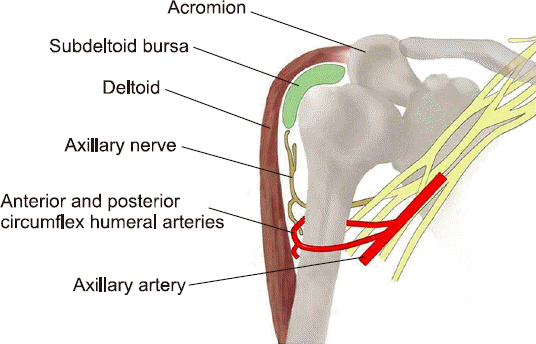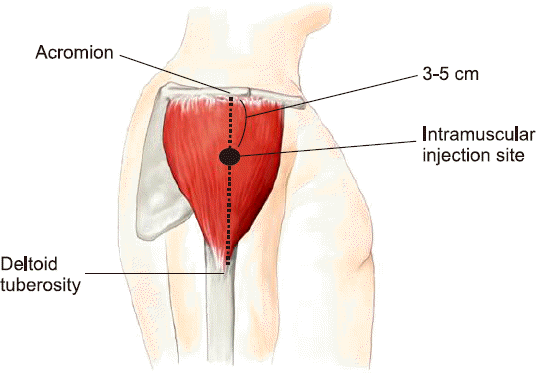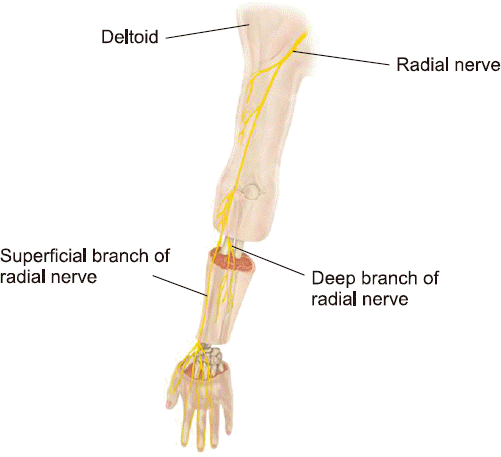1. Mansoor F, Hamid S, Mir T, Abdul Hafiz R, Mounts A. Incidence of traumatic injection neuropathy among children in Pakistan. East Mediterr Health J. 2005; 11:798–804. PMID:
16700396.
2. Sorensen BS, Johnsen SP, Jorgensen J. Complications related to blood donation:a population-based study. Vox Sang. 2008; 94:132–7. PMID:
18028259.
3. Newman BH, Waxman DA. Blood donation-related neurologic needle injury:evaluation of 2 years’worth of data from a large blood center. Transfusion. 1996; 36:213–5. DOI:
10.1046/j.1537-2995.1996.36396182137.x.
6. Davidson LT, Carter GT, Kilmer DD, Han JJ. Iatrogenic axillary neuropathy after intramuscular injection of the deltoid muscle. Am J Phys Med Rehabil. 2007; 86:507–11. DOI:
10.1097/PHM.0b013e31805b7bcf. PMID:
17515691.
7. Loukas M, Grabska J, Tubbs RS, Apaydin N, Jordan R. Mapping the axillary nerve within the deltoid muscle. Surg Radiol Anat. 2009; 31:43–7. DOI:
10.1007/s00276-008-0409-3. PMID:
18766295.
8. Tak SR, Dar GN, Halwai MA, Mir MR. Post-injection nerve injuries in Kashmir:a menace overlooked. J Res Med Sci. 2008; 13:244–7.
9. Choi HR, Kondo S, Mishima S, Shimizu T, Hasegawa Y, Ida K, et al. Axillary nerve injury caused by intradeltoid muscular injection:a case report. J Shoulder Elbow Surg. 2001; 10:493–5. DOI:
10.1067/mse.2001.114682. PMID:
11641710.
10. Nicoll LH1, Hesby A. Intramuscular injection:an integrative research review and guideline for evidence-based practice. Appl Nurs Res. 2002; 15:149–62. DOI:
10.1053/apnr.2002.34142.
11. McGarvey MA, Hooper AC. The deltoid intramuscular injection site in the adult. Current practice among general practitioners and practice nurses. Ir Med J. 2005; 98:105–7. PMID:
15938552.
12. Rodger MA, King L. Drawing up and administering intramuscular injections:a review of the literature. J Adv Nurs. 2000; 31:574–82. DOI:
10.1046/j.1365-2648.2000.01312.x.
13. Apaydin N, Tubbs RS, Loukas M, Duparc F. Review of the surgical anatomy of the axillary nerve and the anatomic basis of its iatrogenic and traumatic injury. Surg Radiol Anat. 2010; 32:193–201. DOI:
10.1007/s00276-009-0594-8. PMID:
19916067.
14. National Center for Immunization and Respiratory Diseases. General recommendations on immunization --- recommendations of the Advisory Committee on Immunization Practices (ACIP). MMWR Recomm Rep. 2011; 60:1–64.
16. Esquenazi Y, Park SH, Kline DG, Kim DH. Surgical management and outcome of iatrogenic radial nerve injection injuries. Clin Neurol Neurosurg. 2016; 142:98–103. DOI:
10.1016/j.clineuro.2016.01.014. PMID:
26827167.
17. Pandian JD, Bose S, Daniel V, Singh Y, Abraham AP. Nerve injuries following intramuscular injections:a clinical and neurophysiological study from Northwest India. J Peripher Nerv Syst. 2006; 11:165–71. DOI:
10.1111/j.1085-9489.2006.00082.x. PMID:
16787515.
19. Edwards WC, Fleming LL. Radial nerve palsy at the elbow following venipuncture-case report. J Hand Surg Am. 1981; 6:468–9. DOI:
10.1016/S0363-5023(81)80105-0.
20. Kim DH, Han K, Tiel RL, Murovic JA, Kline DG. Surgical outcomes of 654 ulnar nerve lesions. J Neurosurg. 2003; 98:993–1004. DOI:
10.3171/jns.2003.98.5.0993. PMID:
12744359.
21. Geiringer SR, Leonard JA Jr. Injection-related ulnar neuropathy. Arch Phys Med Rehabil. 1989; 70:705–6. PMID:
2549911.
23. Puhaindran ME, Wong HP. A case of anterior interosseous nerve syndrome after peripherally inserted central catheter (PICC) line insertion. Singapore Med J. 2003; 44:653–5. PMID:
14770261.
26. Ulrich D, Piatkowski A, Pallua N. Anterior interosseous nerve syndrome:retrospective analysis of 14 patients. Arch Orthop Trauma Surg. 2011; 131:1561–5. DOI:
10.1007/s00402-011-1322-5. PMID:
21611763. PMCID:
PMC3195807.
27. Vialle R, Pietin-Vialle C, Cronier P, Brillu C, Villapadierna F, Mercier P. Anatomic relations between the cephalic vein and the sensory branches of the radial nerve:How can nerve lesions during vein puncture be prevented? Anesth Analg. 2001; 93:1058–61. DOI:
10.1097/00000539-200110000-00052. PMID:
11574383.
28. Sheu JJ, Yuan RY. Superficial radial neuropathy following venepuncture. Int J Clin Pract. 2001; 55:422–3. PMID:
11501238.
29. Thrush DN, Belsole R. Radial nerve injury after routine peripheral vein cannulation. J Clin Anesth. 1995; 7:160–2. DOI:
10.1016/0952-8180(94)00029-4.
30. So E, Sanders GM, Au TK, Hung CT. Radial nerve injury after intravenous cannulation at the wrist--a case report. Ann Acad Med Singapore. 1999; 28:288–9. PMID:
10497685.
32. Boeson MB, Hranchook A, Stoller J. Peripheral nerve injury from intravenous cannulation:a case report. AANA J. 2000; 68:53–7. PMID:
10876452.
33. Sawaizumi T, Sakamoto A, Ito H. Injury of superficial radial nerve on the wrist joint induced by intravenous injection. J Nippon Med Sch. 2003; 70:355–9. DOI:
10.1272/jnms.70.355. PMID:
12928717.
34. Horowitz SH. Peripheral nerve injury and causalgia secondary to routine venipuncture. Neurology. 1994; 44:962–4. DOI:
10.1212/WNL.44.5.962. PMID:
8190306.
36. Kim JS, Yoo SH, Chung ME, Oh JS, Cho DW, Choi GH. Superficial radial nerve and cephalic vein:an anatomic study by cadaver dissection. J Korean Acad Rehabil Med. 2010; 34:394–6.
37. Asheghan M, Khatibi A, Holisaz MT. Paresthesia and forearm pain after phlebotomy due to medial antebrachial cutaneous nerve injury. J Brachial Plex Peripher Nerve Inj. 2011; 6:5. PMID:
21896172. PMCID:
PMC3179920.
38. Stevens RJ, Mahadevan V, Moss AL. Injury to the lateral cutaneous nerve of forearm after venous cannulation:a case report and literature review. Clin Anat. 2012; 25:659–62. DOI:
10.1002/ca.21285. PMID:
22025401.
40. Rayegani SM, Azadi A. Lateral antebrachial cutaneous nerve injury induced by phlebotomy. J Brachial Plex Peripher Nerve Inj. 2007; 2:6. PMID:
17359520. PMCID:
PMC1847431.
41. Horowitz SH. Venipuncture-induced causalgia:anatomic relations of upper extremity superficial veins and nerves, and clinical considerations. Transfusion. 2000; 40:1036–40. DOI:
10.1046/j.1537-2995.2000.40091036.x. PMID:
10988302.
42. Yamada K, Yamada K, Katsuda I, Hida T. Cubital fossa venipuncture sites based on anatomical variations and relationships of cutaneous veins and nerves. Clin Anat. 2008; 21:307–13. DOI:
10.1002/ca.20622. PMID:
18428997.
43. Sin JY, Kim DH, Bun HR, Hwang MR, Kang YK, Kwon HK, et al. Anatomical considerations of lateral and medial antebrachial cutaneous nerves. J Korean Acad Rehabil Med. 2007; 31:329–32.
45. Gentili F, Hudson AR, Kline D, Hunter D. Early changes following injection injury of peripheral nerves. Can J Surg. 1980; 23:177–82. PMID:
7363181.





